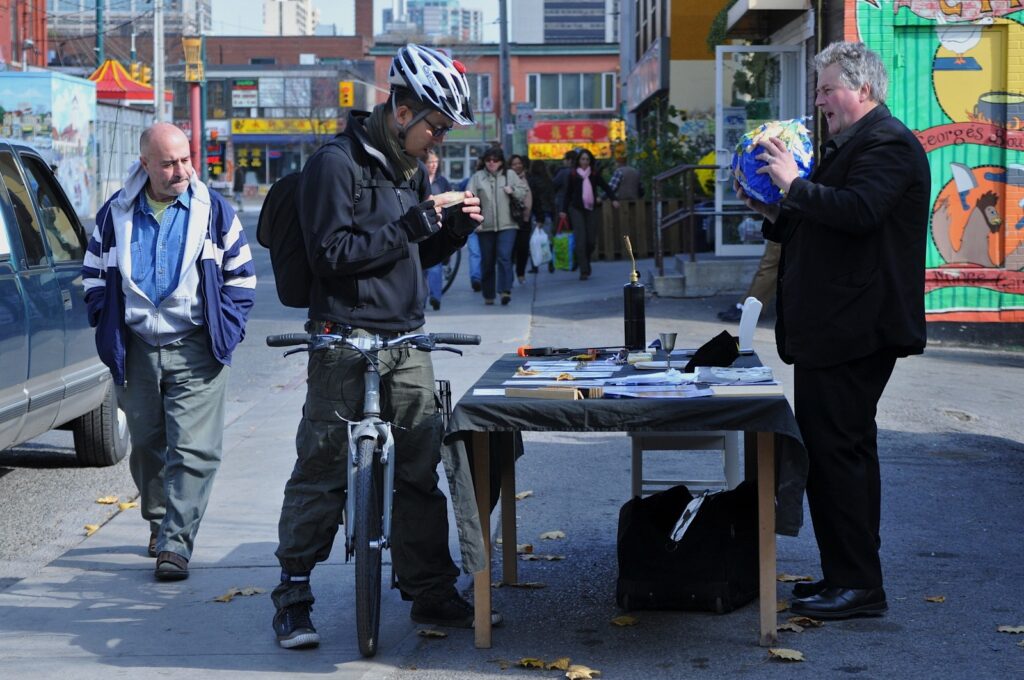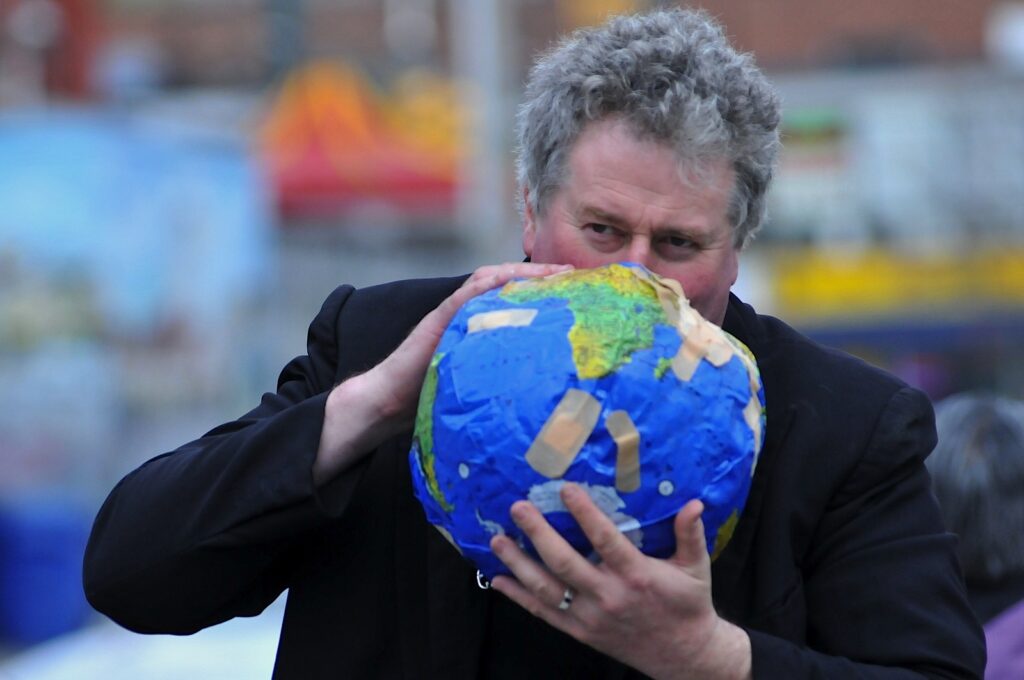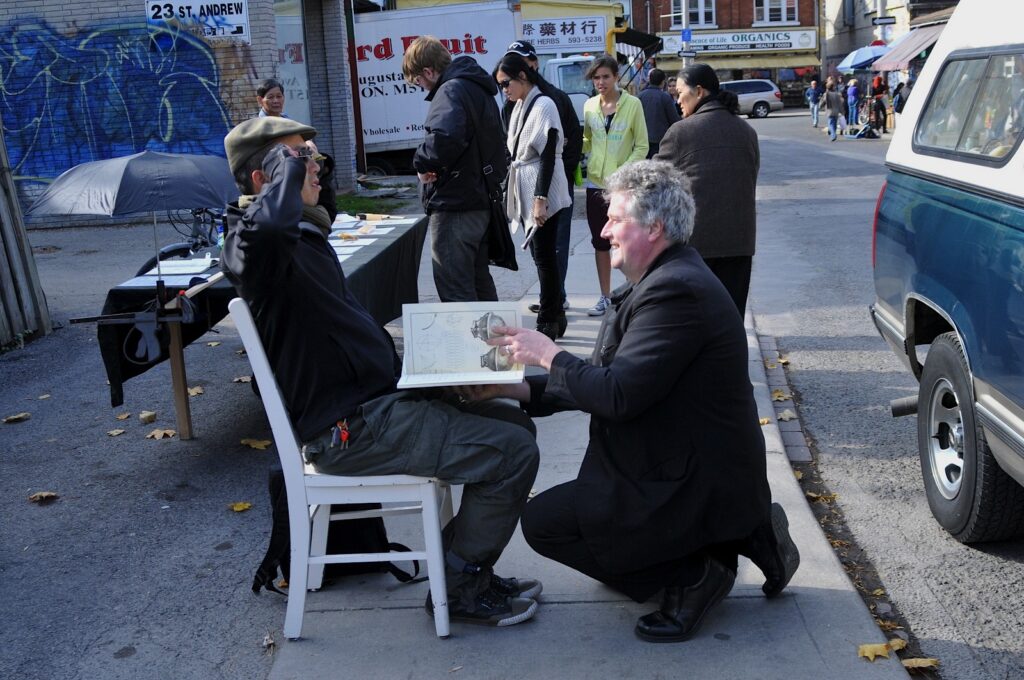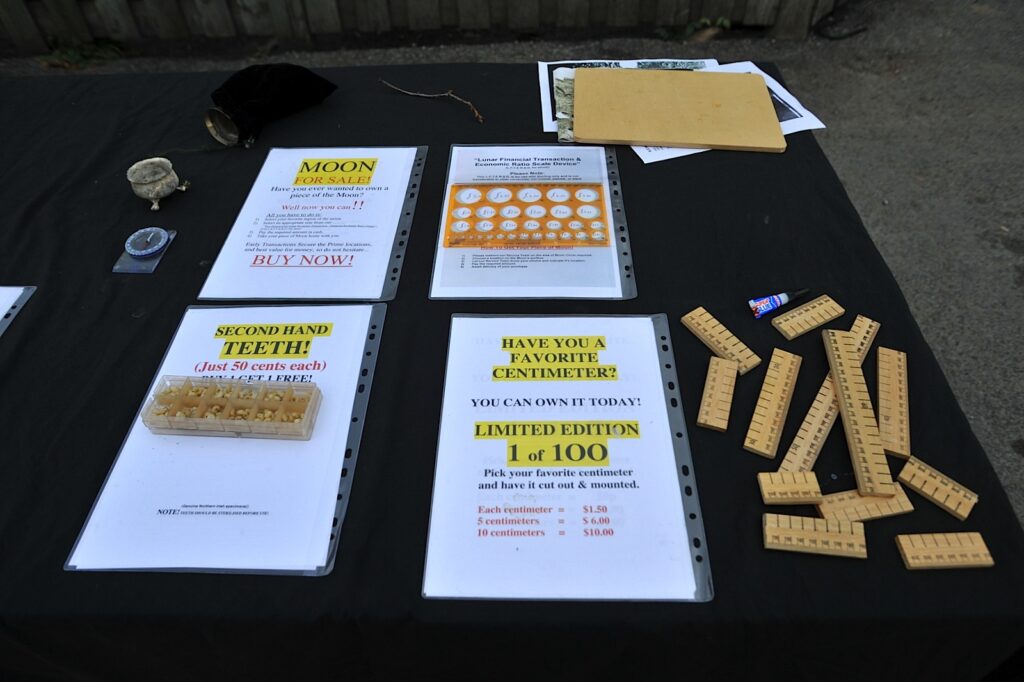By Natalie Loveless
Moon For Sale! Buy Now! Brian Connolly, of Northern Ireland, calls out to the passers-by in the streets of Toronto’s Kensington Market on a Saturday afternoon. Have you a favorite centimeter? You can own it today! Limited Edition: 1 of 100! I approach and survey his wares: A Star Map Umbrella, Second Hand Teeth, Virtual Reality Goggles. Leaves for Sale. Own A Country Today! First Come First Serve!
I am taken by the humour and simplicity of his offerings, and by their steampunk aesthetic. Like a postmodern snake doctor intervening in a normative consumer landscape, Connolly offers useless, evocative, conceptual products that delight or mystify, depending on one’s perspective. I am particularly drawn to the beach ball Earth, covered in band-aids, that Connolly invites passers-by to puncture with darts. Each country is assigned a number of points and, with good enough aim, you can attack a country and win money all at the same time (three darts for a dollar, three dollars if you win).
I am also intrigued by the Virtual Reality Goggles, wire spectacles re-tooled with mirrors. To experience them Connolly has me sit down in a wooden chair and hold a copy of the astronomical volume of Diderot and d’Alembert’s eighteenth century L’Encyclopedie. Through one eye I can see the sky, while, through the other the pages of the L’Encyclopedie are turned sequentially by the artist. A personal tour through the heavens. Over time the two are superimposed: ancient diagrams over blinding white cloud cover.
As I exit the lo-fi augmented reality of the goggles and step back for a moment, it occurs to me that the wares fall, loosely, into three categories: material elements or detritus, representative abstractions or mapping and measuring devices, and practices or experiences. The detritus—Leaves for Sale! Buy One Get One Free! Just 50 Cents Each! Super Seasonal Offer! and Second Hand Teeth! (Just 50 Cents Each) Buy One Get One Free!—evokes consumer society but presents us with natural items—things that are shed in the course of a life cycle. While the teeth appear to be adult teeth, and so they are not truly a sheddable part of the human, individual and incomplete they read more as a dentist’s detritus than as violent trophies of colonization. The leaves, on the other hand, are a totally disposable part of a tree—at least for deciduous trees. The dried leaves covering both the table and the ground are a molting. A gift for the earth. I can’t help but to think of Douglas Adams’ Hitchhikers Guide to the Galaxy, where (at some point in the series) leaves themselves are declared the currency. You can have as much as you can gather, bathe in, sleep on. The representative abstractions—the mapping and measuring devices—include pieces of the moon, countries, and favorite centimeters from a ruler. Each of these is organized around a map: buying a piece of moon involves buying a circle of a map of the moon. Buying a country involves buying a country-sized piece of a map of the world. Buying a centimeter involves buying a centimeter-sized piece of an old wooden ruler. Both ruler and map represent, and measure. In inviting us to “buy” a piece of moon or a centimeter, Connolly asks us to collapse the space between the representation and the represented, offering for sale not the actual product of labour—the map / ruler—but the thing it iconically signifies, that it lays claim to. While the Star Map Umbrella, the Who’s Next dart game and the Virtual Reality Goggles all rely on similar mapping and measuring practices, those practices are brought into the here and now of the performance. Each requires that artist and participant perform actions in time, actions that may themselves serve as advertisements: throwing darts at an inflatable globe, flipping pages while staring into a makeshift device, punching holes out of an umbrella in the form of constellations… Others stop and wonder at Connolly’s offerings.
All day every day, in this society, we traffic in an abstraction: “money.” It seems to me that Brian Connolly’s Market Stall Performance is as much about money itself as any of the things sold. The absurdity of these commodities simply underscores the absurdity of every transaction, in which we exchange small pieces of paper and metal for objects useful and useless, in which we make claims, declare our rights to own and use our worlds.





